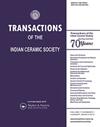Effect of Annealing Temperature on Excitonic Binding Energy and Other Optical Properties of Mn-Ni Co-Doped Transparent ZnO Thin Films
IF 1.5
4区 材料科学
Q3 MATERIALS SCIENCE, CERAMICS
引用次数: 0
Abstract
In this work, low cost sol-gel spin coating technique was successfully employed to deposit Mn-Ni co-doped ZnO (MNZO) thin films on glass substrates. Structural, topographical and optical properties of MNZO thin films were studied in the light of XRD spectra, Raman spectroscopy, SEM, AFM, UV-visible spectroscopy and photoluminescence spectroscopy. XRD study revealed that all annealed ZnO thin films have hexagonal wurtzite structure with (002) preferred orientation along c-axis. Hexagonal wurtzite structure for all films has been confirmed by Raman spectra which show optical phonon modes. Grain size, micropores and RMS surface roughness showed an increasing trend with the rise in annealing temperature as revealed by SEM and AFM images. The experimental data of absorption coefficient was analysed in the light of hydrogenic excitonic model to estimate excitonic binding energy (R) and other optical parameters of the prepared thin films. The excitonic binding energy decreased from 71.55 to 49.2 meV on increasing annealing temperature from 200° to 500°C. Peaks corresponding to UV, violet, green, yellow and orange were clearly observed in photoluminescence spectra for all annealed thin films. The ultraviolet peak shifted towards lower wavelength (blue-shifted) as the annealing temperature was increased. All the peaks in visible region were attributed to transition between complex intrinsic and extrinsic defects. Such films can be a potential candidate for efficient lasers and LEDs and for variety of optoelectronic device applications. GRAPHICAL ABSTRACT退火温度对Mn-Ni共掺杂透明ZnO薄膜激子结合能及其他光学性质的影响
本工作采用低成本的溶胶-凝胶旋涂技术成功地在玻璃衬底上沉积了Mn-Ni共掺杂ZnO(MNZO)薄膜。利用XRD光谱、拉曼光谱、SEM、AFM、紫外可见光谱和光致发光光谱对MNZO薄膜的结构、形貌和光学性能进行了研究。XRD研究表明,所有退火的ZnO薄膜都具有六方纤锌矿结构,沿c轴方向具有(002)择优取向。拉曼光谱显示了光学声子模式,证实了所有薄膜的六方纤锌矿结构。SEM和AFM图像显示,随着退火温度的升高,晶粒尺寸、微孔和RMS表面粗糙度呈增加趋势。根据氢-激子模型对吸收系数的实验数据进行了分析,以估计所制备薄膜的激子结合能(R)和其他光学参数。当退火温度从200°C增加到500°C时,激子结合能从71.55 meV降低到49.2meV。在所有退火薄膜的光致发光光谱中都清楚地观察到对应于UV、紫色、绿色、黄色和橙色的峰。随着退火温度的升高,紫外峰值向较低波长移动(蓝移)。可见光区域的所有峰都归因于复杂的本征缺陷和非本征缺陷之间的过渡。这样的膜可以是高效激光器和LED以及各种光电子器件应用的潜在候选者。图形摘要
本文章由计算机程序翻译,如有差异,请以英文原文为准。
求助全文
约1分钟内获得全文
求助全文
来源期刊

Transactions of the Indian Ceramic Society
工程技术-材料科学:硅酸盐
CiteScore
2.40
自引率
8.30%
发文量
12
审稿时长
2.3 months
期刊介绍:
Transactions of the Indian Ceramic Society is a quarterly Journal devoted to current scientific research, technology and industry-related news on glass and ceramics. The Journal covers subjects such as the chemical, mechanical, optical, electronic and spectroscopic properties of glass and ceramics, and characterization of materials belonging to this family.
The Editor invites original research papers, topical reviews, opinions and achievements, as well as industry profiles for publication. The contributions should be accompanied by abstracts, keywords and other details, as outlined in the Instructions for Authors section. News, views and other comments on activities of specific industries and organizations, and also analyses of industrial scenarios are also welcome.
 求助内容:
求助内容: 应助结果提醒方式:
应助结果提醒方式:


